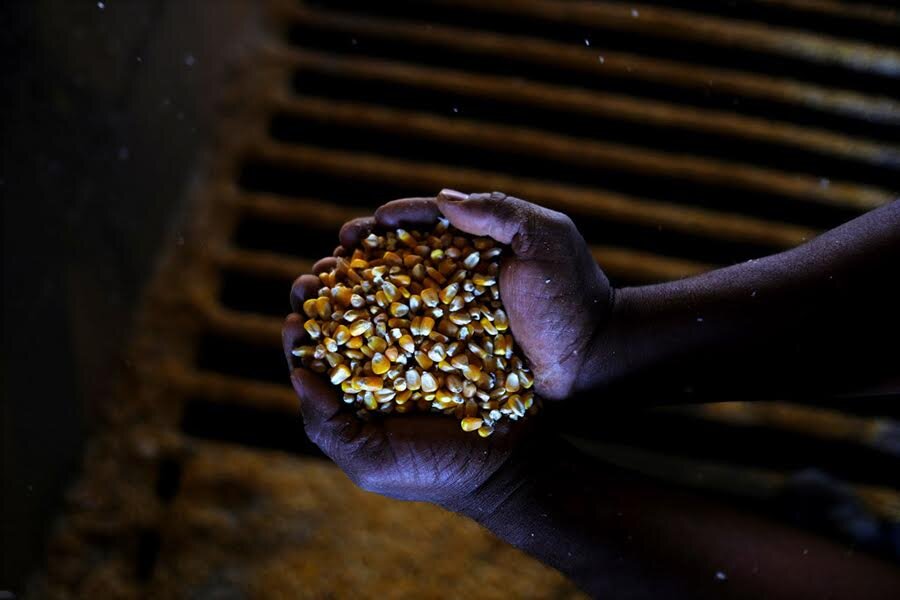Massive harvests of corn, soybeans pose storage problem in Brazil
Loading...
| SORRISO, BRAZIL
At a warehouse in the heart of Brazil's agriculture sector, farmer Rafael Bilibio watches truck after truck line up to unload corn onto the ground outside the huge storage bins.
His own corn, ready for unloading from a 50-tonne truck that has just pulled in, is destined to join the pile that has reached 65 feet high as the bins remain stuffed with soybeans collected earlier this year in Mato Grasso state.
"For the first time in history, producers here will pile one harvest on top of the other," said Mr. Bilibio, 33, who cultivates some 4,700 hectares of soy and corn near Vera in the mid-north of the state.
From Iowa to China, years of bumper crops and low prices have overwhelmed storage capacity for corn, wheat, and other basic foodstuffs. The situation is dragging down farmer incomes and making it hard for traders like Archer Daniels Midland (ADM) and Bunge Ltd to make money.
But here in the world's biggest soybean exporter and the No. 2 corn exporter after the United States, Brazil is seeing these stockpiles on a crop that historically has been an afterthought.
Known as Brazil's second corn – once planted as a cheap way of resting the soil from soybeans – this year's harvest has been so big, and prices so low, that farmers have no choice but to leave it exposed to the elements.
In Mato Grosso, the massive harvest made their options for permanent storage even more limited, as part of the record soybean output still sits in silos while producers wait for prices to rebound.
The pile-up underscores a lack of preparation for these massive harvests in Latin America's largest economy, where chronic logistical bottlenecks have been worsened by farmers' refusal to sell amid slumping prices, with far-reaching effects.
Brazil's stockpiles are exacerbated by the extra corn crop its climate allows, which is set to reach a record 66.6 million tonnes this year out of a total 97.2 million tonnes.
Growers say the grain stocks may still be there when the next soy harvest arrives in January, while carryover volumes for both commodities will end the crop season at a record high, according to government and private estimates.
The pattern of soy hoarding has been repeated across Brazil, pushing local soybean prices down about 23 percent from 69 reais a bag in August 2016, according to Mato Grosso's agricultural research institute Imea.
Farmers' reluctance to sell crimped margins for ADM and Bunge Ltd last quarter as the grain traders had to pay more than they expected for soybean supplies to meet commitments.
"I would sell my soybeans if prices reached 62 reais a bag," Mato Grosso farmer Cayron Giacomelli told Reuters. There were bids at 55 reais locally and he still has 15 to 20 percent of the soybeans tucked away.
Quick fix?
At two warehouses near the towns of Sorriso and Lucas do Rio Verde, there is enough corn piled up outside to feed about 108,000 pigs for a year.
About 3 percent of the corn left outdoors may be damaged, according to growers association Aprosoja head Endrigo Dalcin, but the current dry weather reduces the odds of spoiling.
The mounds of grain are a testament to a lack of warehouses in Mato Grosso, where the storage gap is estimated at 39 million tonnes, says Aprosoja.
As such, some farmers are jumping on a quick fix common in Argentina: the silo bag, consisting of long sheaths of plastic to shelter crops in the field from rain and wind.
Maria Amélia Tirloni, who farms 5,500 hectares of corn and soybeans in Tapurah, said the state's infrastructure woes puts them at a disadvantage.
Aside from the distance between farms and consumer markets, she claims roads are bad and insufficient there.
"The storage issue also makes farmers hostage to abusive freight rates during harvest," says Ms. Tirloni. Tapurah, which is far from the nearest railroad, relies on shipping by trucks that often travel more than 2,100 kilometers (1,300 miles) to port.
But farmers will need to make room for the next soy crop, planted in September and harvested in January, when heavy rains could put their big cash crop at risk.
With second corn, Brazil boosted exports between these months, but doubts linger on whether farmers will be able to move their entire production now.
"This situation may affect the next soy harvest if the corn is not sold," Mr. Dalcin said. "We are worried about the lack of space."
This story was reported by Reuters.







